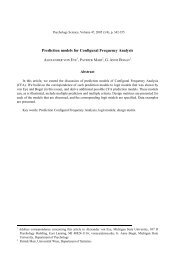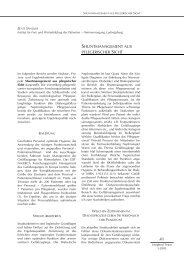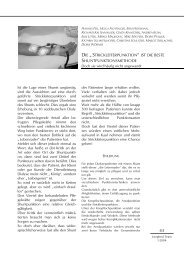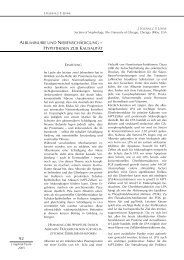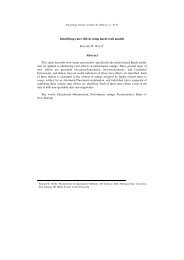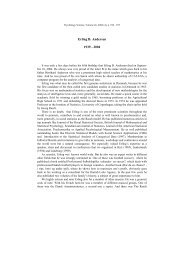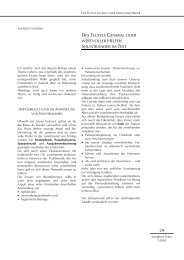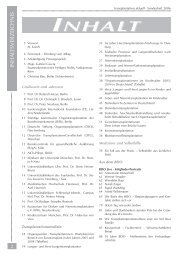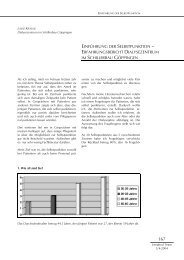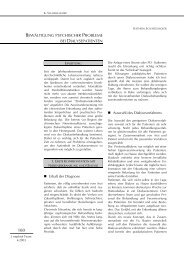Download PDF of the full article - Pabst Science Publishers
Download PDF of the full article - Pabst Science Publishers
Download PDF of the full article - Pabst Science Publishers
You also want an ePaper? Increase the reach of your titles
YUMPU automatically turns print PDFs into web optimized ePapers that Google loves.
200 T. Kováč<br />
Creativity and its intra-psychic bounds<br />
Creativity, as a matter <strong>of</strong> fact, is <strong>the</strong> only capability that distinguishes a man from o<strong>the</strong>r<br />
beings. There do exist <strong>the</strong> following three axioms (according to our long-term studies):<br />
1. Creativity is <strong>the</strong> ability <strong>of</strong> every human being.<br />
2. We can fi nd it in every human activity.<br />
3. It can be developed not only by special programs (what a luck for many <strong>of</strong> our<br />
collegues) but also throughout education or <strong>the</strong> family and last but not least it is<br />
infl uenced by <strong>the</strong> way and <strong>of</strong> course <strong>the</strong> quality <strong>of</strong> life.<br />
As known, creativity goes hand in hand with talent (or giftedness – we do not distinguishes<br />
<strong>the</strong>se two terms and use <strong>the</strong>m as synonyms, as according to <strong>the</strong> literature, <strong>the</strong>re are not very<br />
plausible differences in <strong>the</strong>oretical explanations). Maybe <strong>the</strong> highest one could be <strong>the</strong> socalled<br />
“creative talent”. The results <strong>of</strong> our investigations on talent development (Dočkal & T.<br />
Kováč, 1993) can be summarized in <strong>the</strong> following <strong>the</strong>sis:<br />
1. A gift (talent) is formed on <strong>the</strong> basis <strong>of</strong> genetic dispositions throughout life. The<br />
conditions <strong>of</strong> <strong>the</strong> environment and <strong>the</strong> very activity <strong>of</strong> an individual are signifi cant<br />
factors acting in its creation.<br />
2. Not every gifted child becomes an exceptional adult, but most adult talents behaved as<br />
talented individuals in <strong>the</strong>ir childhood.<br />
3. A gift regulates <strong>the</strong> activity <strong>of</strong> a human being. As a characteristic <strong>of</strong> a personality,<br />
a gift is in possession <strong>of</strong> every human being. It has a continual character in relationship<br />
to effectiveness. It may be quantifi ed by this criterion.<br />
4. The qualitative aspect <strong>of</strong> a gift is based on its structure which conditions <strong>the</strong> socalled<br />
type <strong>of</strong> talent (it is differentiated in accordance to <strong>the</strong> classifi cation <strong>of</strong> human<br />
activity)<br />
5. A gift is a multi-dimensional phenomenon. Its structure consists <strong>of</strong> a) a preconditioning<br />
constituent (somatic characteristics, abilities, skills, acquirements and competencies);<br />
b) an activating constituent (non-specifi c motivation, will attributes, personality<br />
orientation)<br />
6. Creativity is a signifi cant part <strong>of</strong> both constituents <strong>of</strong> talent (creative abilities, creative<br />
motivation). Ins<strong>of</strong>ar as creativity plays a signifi cant and dominant role in <strong>the</strong> structure<br />
<strong>of</strong> talent, we may speak about creative talent. As mentioned, we understand creativity<br />
also as a quality <strong>of</strong> every human being. A noncreative human being rarely exists (it<br />
may be in <strong>the</strong> most serious cases <strong>of</strong> olygophreny). Our results also show, that <strong>the</strong><br />
preschool age is <strong>the</strong> gate to <strong>the</strong> world <strong>of</strong> creativity.<br />
7. The particular components <strong>of</strong> ei<strong>the</strong>r constituents <strong>of</strong> talent possess a hierarchic<br />
orderliness that is also related to <strong>the</strong> type <strong>of</strong> talent. The most general components <strong>of</strong><br />
talent – which are involved in every kind <strong>of</strong> activity – are <strong>the</strong> intellectual abilities,<br />
creative abilities, as well as achievement motivation (a need for self-assertion). On<br />
inferior degrees <strong>of</strong> this hierarchy, <strong>the</strong>re are attributes which specify <strong>the</strong> respective<br />
type <strong>of</strong> talent. Never<strong>the</strong>less, some attributes may play a general role in <strong>the</strong> relation<br />
to one activity (a type <strong>of</strong> talent) a special role in relation to ano<strong>the</strong>r activity (a type <strong>of</strong><br />
talent).<br />
8. The differentiation <strong>of</strong> talents begins in a course <strong>of</strong> <strong>the</strong> development when <strong>the</strong> focus <strong>of</strong><br />
talent is being gradually shifted from its general characteristics onto <strong>the</strong> special ones.<br />
Some common traits, however, remain persevered.



